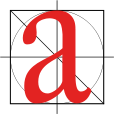- Cicero (typography)
-
1 cicero = SI units 4.500×10−3 m 4.5000 mm US customary / Imperial units 14.76×10−3 ft 0.17717 in A cicero (
 /ˈsɪsəroʊ/) is a unit of measure used in typography in Italy, France and other continental European countries, first used by Pannartz and Sweynheim in 1468 for the edition of Cicero's Epistles, Ad Familiares. The font size thus acquired the name cicero.
/ˈsɪsəroʊ/) is a unit of measure used in typography in Italy, France and other continental European countries, first used by Pannartz and Sweynheim in 1468 for the edition of Cicero's Epistles, Ad Familiares. The font size thus acquired the name cicero.It is 1⁄6 of the historical French inch, and is divided into 12 points, known in English as French points or Didot points.
The measure-term cicero is thus used similarly to an English pica, although the French inch was slightly larger than the English inch; there are about 1.063 picas to a cicero.
Cicero (and the points derived from cicero) was used in the lead-days of typography - in continental Europe. Nowadays all computers use pica (and the points derived from pica) as font size measurement - alongside with millimeters for the line length, and paper size measurement.
Cicero = 4.5 mm. Pica = 4.23333333 mm.
Typography terminology Page 
Paragraph Character Typeface anatomyCounter · Diacritics · Dingbat · Glyph · Initial · Kerning · Letter-spacing · Ligature · Subscript and superscript · Swash · Text figuresCapitalizationVertical aspectsClassifications Punctuation Typesetting Calligraphy · ETAOIN SHRDLU · Font (Computer font) · Font catalog · Letterpress · Lorem ipsum · Movable type · Pangram · Phototypesetting · Punchcutting · Type design · Typeface · Type foundry · MicrotypographyTypographic units Digital typography Categories:- Units of length
- Typography
Wikimedia Foundation. 2010.
